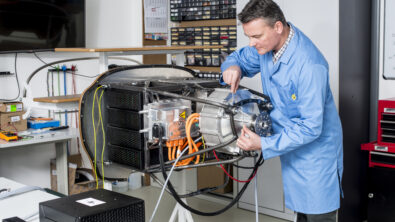From highway to skyway: Are flying cars coming soon?

Flying cars have long been a hallmark of the future, capturing our imaginations for decades. However, these visions of airborne vehicles were always the stuff of make-believe and have remained grounded in fiction to this day. But as technology continues to advance, many experts believe the prospect of flying cars may no longer be confined to the frames of Hollywood films or to the pages of science fiction novels. In fact, they could even be closer to becoming a reality than we think.
Electric vertical takeoff and landing (eVTOL) vehicles, otherwise known as flying cars, offer the potential to radically change transportation as we know it. In this blog, we’ll explore the obstacles eVTOL vehicles face, the benefits they offer and the trajectory of this potentially revolutionary technology.
Do we really need airborne vehicles?
As our global population surges, cities face the pressing challenge of maintaining efficient transportation systems despite growing demand. Conventional roads have reached a point of saturation and it’s apparent that we need a solution to revolutionize mobility. In a recent article, SemiWiki explores some reasons why eVTOL vehicles may become a mainstream reality, offering a glimpse into a possible solution for various urban challenges.
First, traffic-choked roads have unfortunately become the norm in almost every major city around the world. This extreme road congestion not only hampers efficient transportation but also poses a multitude of safety hazards for citizens. Flying cars in the form of electric air taxis could significantly reduce commute times by utilizing airspace to escape the daily bumper-to-bumper holdups. Having air taxis would create space on the ground and even improve the air quality in smoggy, overcrowded cities.
In addition to alleviating gridlock issues, flying cars could address accessibility challenges by providing transportation options in rural areas with limited infrastructure. For example, communities in remote landscapes are often left to rely on their own limited resources when disasters occur. Flying cars could be a straightforward way to connect isolated areas with critical supplies from more populated spaces.
Finally, eVTOL vehicles could enhance emergency response systems by offering much faster response times. Additionally, flying vehicles could expedite the transport of urgent medical equipment and bring injured individuals to safety significantly quicker.
Hurdles on the horizon
While the case for eVTOL vehicles is compelling, making them a reality comes with plenty of challenges and a host of unknowns. One of the main challenges flying cars face is a lack of infrastructure. Popularizing eVTOL vehicles will require the development of structures like charging stations, takeoff and landing zones and instituting an entire new set of regulations—a significant undertaking that will require intense planning.
Noise issues are also a cause of major concern when designing flying cars. Urban areas worry about the amount of noise emissions coming from a sky filled with vehicles, disturbing the tranquility of suburban neighborhoods. Engineers will be tasked with creating quieter propulsion systems, which will be costly and demanding at best.
Additionally, it may take years before we really understand eVTOL vehicle safety. Technologies like autonomous flight systems, collision avoidance mechanisms and fail-safe protocols must be developed and implemented prior to market introduction. Not to mention, once eVTOL vehicles are available to consumers, who will we entrust to fly them? Will obtaining a license for eVTOL operation be as straightforward as acquiring one for conventional cars, or will individuals have to complete eVTOL courses akin to commercial pilot training? These questions underscore why a meticulous approach to safety and planning are necessary to minimize the risk of accidents and essential to gaining the public’s trust.
The sky’s the limit
So, how soon until we’re commuting through the clouds? In short, there’s no concrete timeline, but the technology is at the brink. According to a recent CNN article, the Federal Aviation Administration (FAA) just granted an eVTOL vehicle with a special airworthiness certification, meaning the company will be allowed to road and air test the car. This vehicle/aircraft duo is electrically powered with the ability to drive on public roads as well as take to the skies—something no other eVTOL has been capable of doing.
This exciting progress in eVTOL technology suggests that the era of airborne mobility is within reach. The future of flying cars depends on the collaborative alliance between engineers, policymakers, and industry leaders. As urbanization accelerates, rethinking conventional methods of transportation is imperative—and eVTOL vehicles may promise new levels of efficiency, accessibility and safety to citizens worldwide.
Siemens Digital Industries Software helps organizations of all sizes digitally transform using software, hardware and services from the Siemens Xcelerator business platform. Siemens’ software and the comprehensive digital twin enable companies to optimize their design, engineering and manufacturing processes to turn today’s ideas into the sustainable products of the future. From chips to entire systems, from product to process, across all industries. Siemens Digital Industries Software – Accelerating transformation.


